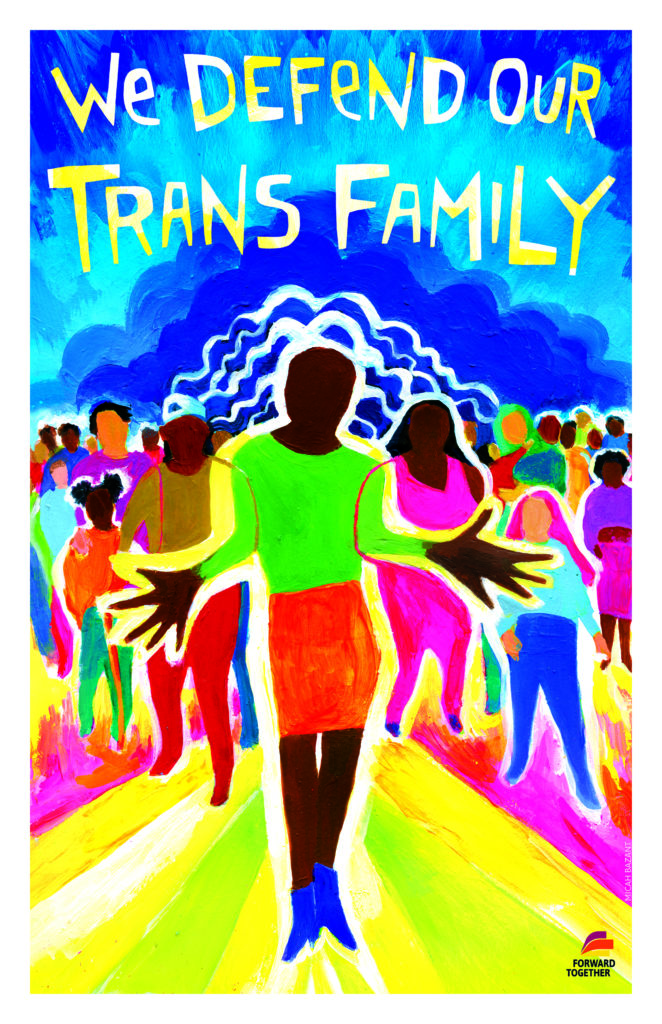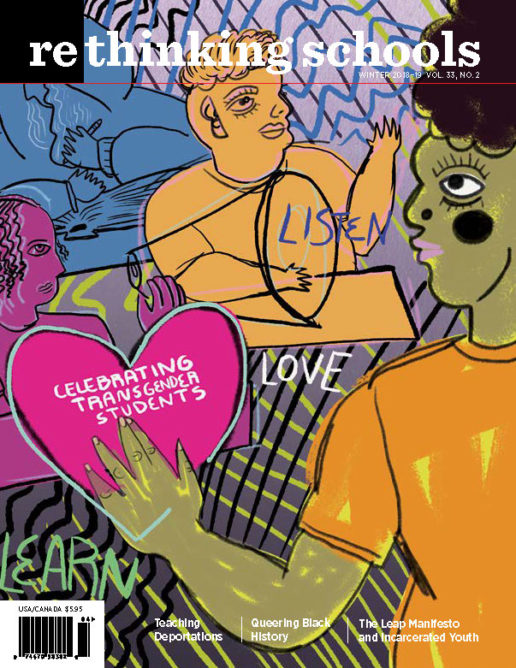Celebrating Transgender Students in Our Classrooms and in Our Schools
Illustrator: Micah Bazant

Students tell us what they need verbally, behaviorally, and statistically. Transgender students also collectively tell us through high dropout rates, absenteeism, their rates of homelessness, and drug abuse. And they tell us through their frighteningly high suicide attempts — 41 percent of transgender students attempt suicide compared to 1.6 percent of the general population.
In their heartbreaking article in this issue, “Teaching Them into Existence” (p. 12), Mykhiel Deych writes about the suicide of their transgender student, Lilith: “Teaching isn’t supposed to include life-or-death consequences, but it does. When it comes to LGBTQ students, we fail to hold space for their existence. Heterocentric, cisnormative curriculum writes out the existence of LGBTQ lives.”
The issue is compounded because so much of our society works to erase transgender lives. In October 2018, the New York Times reported, “The Trump administration is considering narrowly defining gender as a biological, immutable condition determined by genitalia at birth, the most drastic move yet in a governmentwide effort to roll back recognition and protections of transgender people under federal civil rights law.” Meanwhile, the U.S. Department of Health and Human Services has deliberately moved to erase the existence, the acknowledgement, the protection of 149,750 transgender youth (ages 13-17) and 1.4 million transgender adults, not to mention those who are born intersex.
So, what can teachers, schools, and districts do to meet the needs of trans students? To make them visible? To keep them alive? To celebrate them?
Names and Pronouns
Every teacher, school, and district must honor the identities of transgender students by using their chosen name and pronoun, even when it contradicts what’s on their birth certificate or classroom roster. In Deych’s other article in this issue, “On Behalf of Their Name: Using They/Them Pronouns Because They Need Us To” (p. 8), student Olive told the faculty at their school, “Everything in our society is binary, it’s not just gender. But when you don’t fit into that binary, take a step back and you’re like, but what about me? And it’s just — it feels like — there’s not a place for me in this society.”
Naming acknowledges existence. One of the first actions colonizers took when they pillaged a new country was to rename mountains, rivers, roads, every nook and cranny in their own language because to erase a name is to erase ownership and identity. Similarly, during slavery calling enslaved people by a common name, like Sally or boy, or not addressing them with their title and surname, was a means of exerting control. In the same way, refusing to address transgender people by their chosen name or pronoun erases their presence, their right to a space and place in the school or classroom, and it maintains the gender binary social order that excludes them. One of the first actions of newly emancipated people was to rename themselves.
Recognizing this language problem, the National Council of Teachers of English (NCTE) issued its “Statement on Gender and Language” in October of 2018, boldly addressing both the grammar and the politics of pronouns:
Language, which plays a central role in human cognition and behavior, is one of the most common mechanisms by which gender is constructed and reinforced. The words that people use to describe others or objects are often unintentionally but unquestionably based on implicit cultural biases that privilege the gender binary. . . . NCTE is concerned about the critical role that language plays in perpetuating gender bias, including binary understandings of gender and gender norms. Through careful attention to language as it relates to gender, [teachers] have the opportunity to influence inclusive and supportive thought and behavior both directly and indirectly.
Deych’s article shares one Gay-Straight Alliance’s (GSA) journey to crack their school’s consciousness by raising awareness and directly asking teachers to attempt to use correct pronouns. Schools and school districts should download and discuss the NCTE statement as they reframe their own language and actions. In fact, they might take NCTE’s advice and “[c]onduct an internal audit of written material representing the school and/or district and, where needed, direct the revision of material to eliminate binary language.”
While adults struggle with the pronouns, the idea of gender fluidity, and transgender people, kids who read or experience transgender people early seem to understand the grey areas and the blurriness way before adults. Nine-year-old Xavier, for example, read the book George, about a transgender girl and talked about how unfair it was that George wasn’t considered for the key role in a play. He’s not confused, nor are his 4th-grade classmates who excitedly read and shared the book that made the Oregon Battle of the Books list, only to be banned by some districts. (See “What Kind Are You? Transgender Characters in Children’s Literature” p. 18.) They understand that George’s issue is not actually about bathrooms, it’s about control and fear.
Curriculum
Schools must normalize transgender lives through literature and curriculum. As Lora Worden writes in her review of transgender books in this issue, students shouldn’t have to wait until they read chapter books to learn about transgender characters. This is a service not only for trans students who feel endangered or invisible, but also for cisgender students. Disrupting bullying against LGBTQ students — who are the most likely to be bullied Ñ can begin with building empathy. As a department or district, teachers should seek gender diversity in their text selection, including texts written by transgender and nonbinary authors and about transgender and nonbinary characters and experiences.
Language arts teachers can also address the ways in which language moves in response to social forces by creating lessons on the politics of grammar and usage. Students might examine the ways Chicago Manual of Style and other style books have changed over the years as they respond to social upheavals, in this case determining that the pronoun “they” is appropriate to use in writing when referring to singular antecedents, including when writing for publication. Teen Vogue‘s back-to-school issue in August 2018 published an article “How to Use Gender Neutral Words and Why They Are Important,” which could be used as a model for showing students not only how to make their language more inclusive, but also how to write an essay that teaches others about the bias in language. For example, the article tells students: “When we speak about ‘mankind’ or ‘the achievements of man,’ what we’re doing is confirming the subconscious bias that men are intellectually, morally, and physically superior to women, which is clearly untrue.”
Social studies teachers might follow the lead of a collective of teachers in Portland, Oregon, who created a unit called “Queering Portland.” These high school history and art teachers collected articles and artifacts to help students examine both the history of bigotry and abuse faced by the LGBTQ community locally, but also that community’s resistance.
Teachers across curricular areas should take NCTE’s advice to “[s]eize and create classroom opportunities to discuss and challenge gender assumptions, particularly binary assumptions about gender. This may include teaching students how to be alert and ready to question texts as varied as classroom materials to newscasts to school rituals and traditions — homecoming princesses, prom queens, etc. — that are riddled with sexism, heteronormativity, and dangerously gendered scripts.
Bathrooms
In February 2017, the Trump administration repealed a critical Obama decision. According to the New York Times, “In a joint letter, the top civil rights officials from the Justice Department and the Education Department rejected the Obama administration’s position that nondiscrimination laws require schools to allow transgender students to use the bathrooms of their choice.”
While the courts and Trump wrangle over whether gender-neutral bathrooms should exist, they already are in place in many schools, but more are needed in states and school districts that refused to implement nondiscrimination federal policy. Indeed, multiple gender-neutral bathrooms are necessary so that trans students and staff don’t have to traverse the entire school or wait in lines to use the bathroom. In new school designs, gender-neutral bathrooms have become the norm.
But transgender students currently attending schools cannot wait for the courts to decide where they can pee or for communities to cough up funds to remodel existing bathrooms. If your school does not currently have a gender-neutral bathroom, get creative. Most schools have gendered, single stall bathrooms for staff members. These facilities could be opened as gender-neutral bathrooms. Don’t wait for permission, act for the rights of transgender students now.
Gay-Straight Alliance
As Deych’s article demonstrates, the GSA (sometimes also called the Queer-Straight Alliance) provided a safe space to discuss issues, but also created a gathering place where students nurtured their collective power to exert change. According to a 2014 article at Smithsonian.com, a large study conducted in Canada demonstrated that schools with GSAs dramatically reduce suicide risks for all students.
When we build inclusive communities for transgender students, we are all forced to think more deeply about our humanity and how we approach identity. Throughout our history, people in our society have been taught a gender binary that divides humanity in half and assigns some characteristics to one half and different characteristics to the other. We all become poorer in that cleaving. When we introduce transgender people into the curriculum, it allows us to think more expansively and imaginatively about gender and identity, and invites everyone to rethink who “we” are. Every action we take in schools to welcome those who have been traditionally marginalized reminds us that we are doing this work for all of us, helping all of us become better human beings.

